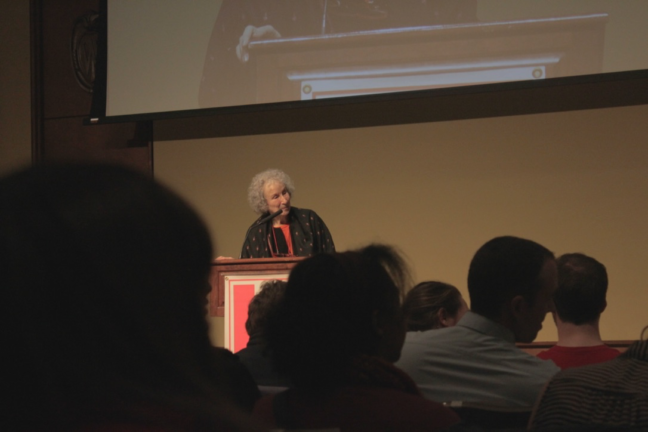As part of Wisconsin Union Directorate’s Distinguished Lecture Series, writer and activist Margaret Atwood emphasized the role of science and technology when creating modern versions of magic in literature Monday.
While she is most-known for her novel “The Handmaid’s Tale,” Atwood’s most recent book “Hag-Seed” acts as a modern-day adaptation of William Shakespeare’s “Tempest.”
Atwood is a winner of multiple international literary awards and the author of more than 40 volumes of poetry. Coming to Madison, Atwood looks at her writing process and some of the challenges that go along with reworking a classic piece from Shakespeare.
“Hag-Seed” is set in a Canadian prison and focuses on a group of prisoners who put on a production of “Tempest.” The characters themselves take on the roles of “Tempest” characters in their life while inside the prison.
In “Hag-Seed,” Atwood shifted the original setting of “Tempest” more than 400 years. For Atwood, the challenge when writing rested with trying to find modern day equivalents to Shakespearean language and characters.
It was crucial for Atwood that “Hag-Seed” take place in a prison setting because “everyone in [‘Tempest’] turns out to be imprisoned by someone in someway at sometime.”
Because of this prison setting, the prisoners’ play takes digital form, as it would be against regulation for a group of prisoners to gather to watch as play. Because of this, science and technology becomes a crucial part of her novel.
Ariel, a fairy-like character in the original “Tempest,” presented the key translative challenge to Atwood.
Eventually, Ariel became a hacker imprisoned for fraud who digitizes the prison production in Atwood’s version, working mysteriously behind the scenes, a trait common to both fairies and hackers.
Atwood said she couldn’t avoid writing a Shakespearean novel because love of Shakespeare is a key piece of her identity.
The “Tempest” in particular has always stood out to Atwood.
Distinguished Lecture Series speaker says struggle may be one way to forge new identity
“If I couldn’t write a novel based on the ‘Tempest’ I didn’t want to write on Shakespeare at all,” Atwood said.
Atwood visited Madison to present a keynote address at the Center for Humanities’ Great World Texts student conference, which connects UW faculty with high school teachers. As part of the program, the high school students this school year focused on Shakespeare’s “The Tempest.”










